The Importance Of Water Quality In Your Frog Pond: Keeping Amphibian Friends Happy and Healthy
Frogs need a clean, healthy pond to thrive in your backyard. A frog-friendly pond isn’t just a pretty water feature. It’s a living ecosystem that supports these fascinating amphibians. Good water quality is crucial for frog health and reproduction.
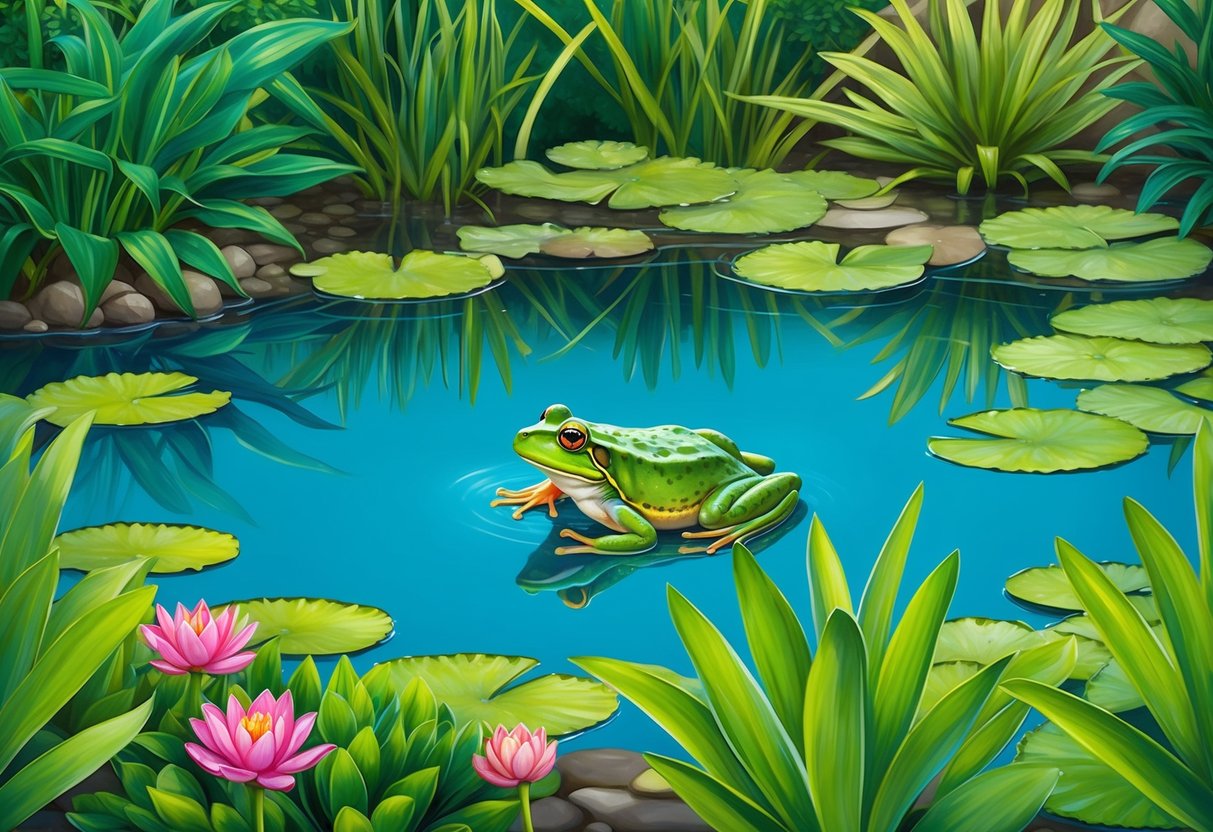
Creating the right environment for frogs means paying attention to water quality. Your pond’s water affects everything from oxygen levels to food sources for your amphibian friends.
Clean water helps frogs breathe, eat, and stay safe from diseases.
You can make a big difference for frogs with some simple steps. By learning about pond ecosystems and water quality, you’ll be able to create a perfect frog habitat right in your own yard. Your efforts will help local frog populations and add some natural charm to your outdoor space.
Key Takeaways
- Clean water is vital for frog health and survival in your pond
- Your pond’s ecosystem needs regular care to stay balanced
- Simple steps can greatly improve water quality for frogs
Understanding Pond Ecosystems

A frog pond is a complex system with many parts working together. Water plays a key role in keeping frogs happy and healthy. The natural water cycle also affects how frogs live and grow in their pond home.
Roles of Water in a Frog Pond
Water is vital for frogs in many ways. It helps them breathe, stay cool, and move around. Frogs need clean water to lay their eggs and for tadpoles to grow.
Water quality affects how well frogs can live in your pond. Clean water has the right amount of oxygen for frogs to breathe through their skin. It also keeps algae growth in check.
Frogs use pond water to keep their skin moist. This helps them take in oxygen and stay at the right temperature. Without enough water, frogs can dry out and die.
Natural Water Cycles and Frogs
The water cycle affects frog ponds in big ways. Rain adds fresh water and washes in nutrients. Too much rain can flood the pond, while not enough can make it too dry.
Seasons change how much water is in the pond. This impacts when frogs breed and how tadpoles grow. In spring, more water helps frogs lay eggs. In summer, some ponds may dry up, forcing frogs to find new homes.
Pond ecology shows how water levels affect plants and bugs frogs eat. When water levels drop, it can harm frog food sources. Keeping your pond at the right depth helps frogs thrive year-round.
Factors Influencing Water Quality
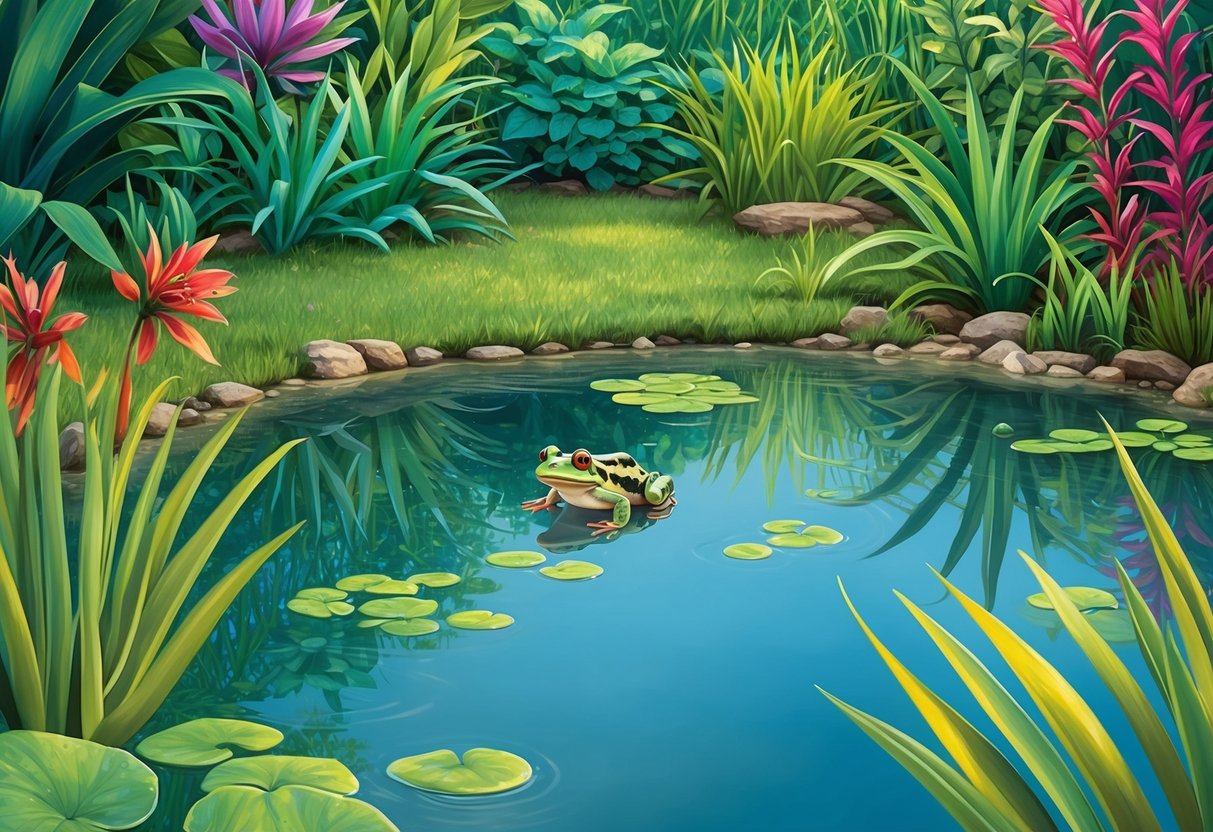
Water quality in your frog pond depends on several key elements. These factors work together to create a healthy environment for your amphibian friends.
Chemical Balances
The right chemical mix is crucial for your frog pond. pH levels are very important for frogs. Aim for a pH between 6.5 and 7.5. This slightly acidic to neutral range suits most frog species best.
Ammonia and nitrate levels also matter. These come from frog waste and decaying plants. Too much can harm your frogs. Test the water often and do partial changes if levels get too high.
Oxygen is vital too. Plants help add oxygen, but you might need a small pump for extra air. Frogs breathe through their skin, so good oxygen levels keep them healthy.
Physical Parameters
Temperature plays a big role in frog health. Most pond frogs like water between 70-80°F (21-27°C). In hot weather, make sure your pond has shady spots to cool off.
Water depth affects frogs too. Include shallow areas for tadpoles and deeper spots for adult frogs. A mix of depths creates a good habitat for all life stages.
Clarity is another key factor. Murky water can stress frogs and hide problems. Use a simple net to remove debris. Plants help naturally filter the water, keeping it clearer.
Effects of Poor Water Quality on Frogs
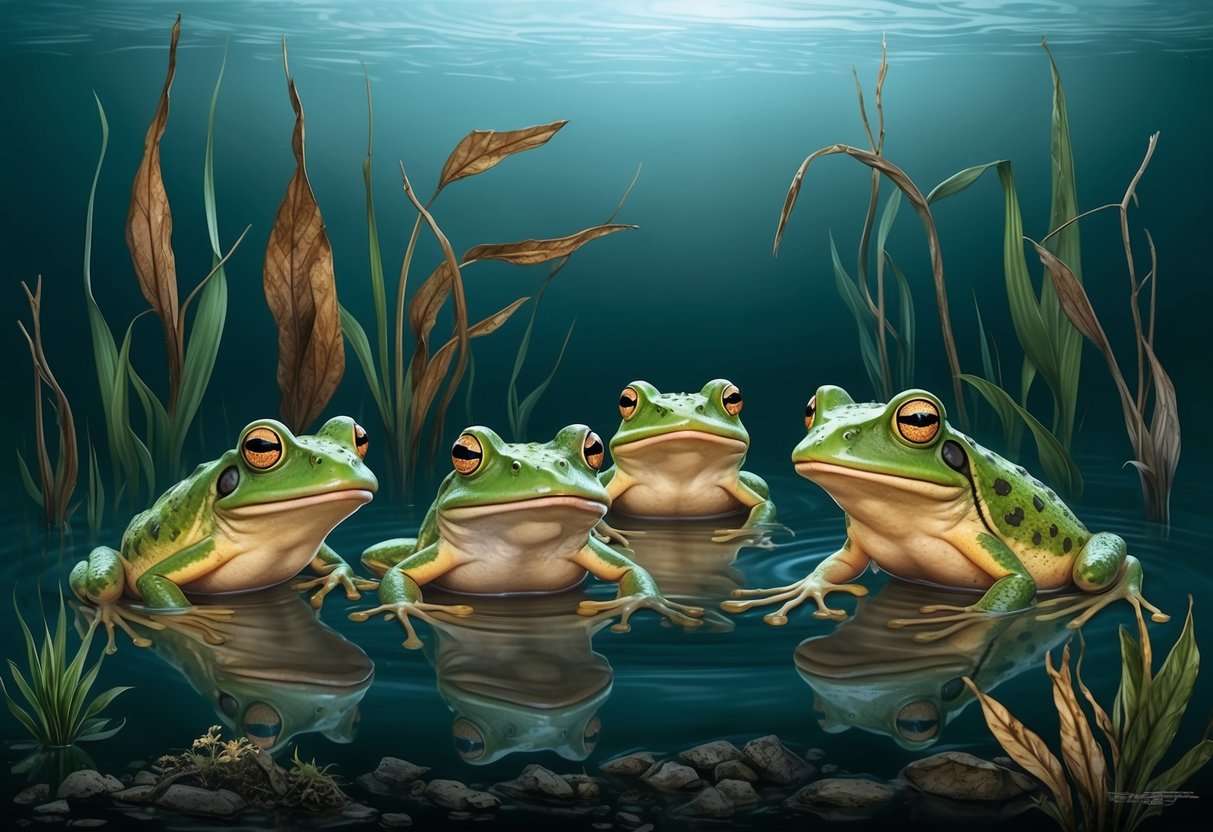
Bad water in frog ponds can hurt frogs in many ways. It can make them sick and change how they grow and act. Let’s look at some of these effects.
Health Concerns for Amphibians
Poor water quality can cause big problems for frogs’ health. Dirty water often has harmful germs and chemicals that can make frogs sick. These yucky things in the water can give frogs skin diseases or make it hard for them to breathe.
Frogs breathe through their skin, so bad water hurts them a lot. Too much algae in the pond can use up oxygen, making it hard for frogs to live. Chemicals from nearby farms or roads can poison frogs. This can make them weak or even kill them.
Some frogs might get weird bumps or sores on their skin from dirty water. Others may have trouble fighting off normal frog illnesses. Your frogs need clean water to stay healthy and happy!
Impact on Frog Behavior and Development
Bad water can change how frogs grow and act. Polluted water can cause problems for baby frogs as they grow. They might not grow right or could end up with strange body shapes.
Frogs in dirty water often don’t move around as much. They might not eat well or mate like they should. Some frogs might leave the pond to find cleaner water. This can be dangerous for them.
Tadpoles in bad water might not turn into frogs the right way. They could grow too slowly or have trouble swimming. Clean water helps frogs lay healthy eggs. But in dirty water, many eggs might not hatch at all.
Monitoring Your Frog Pond
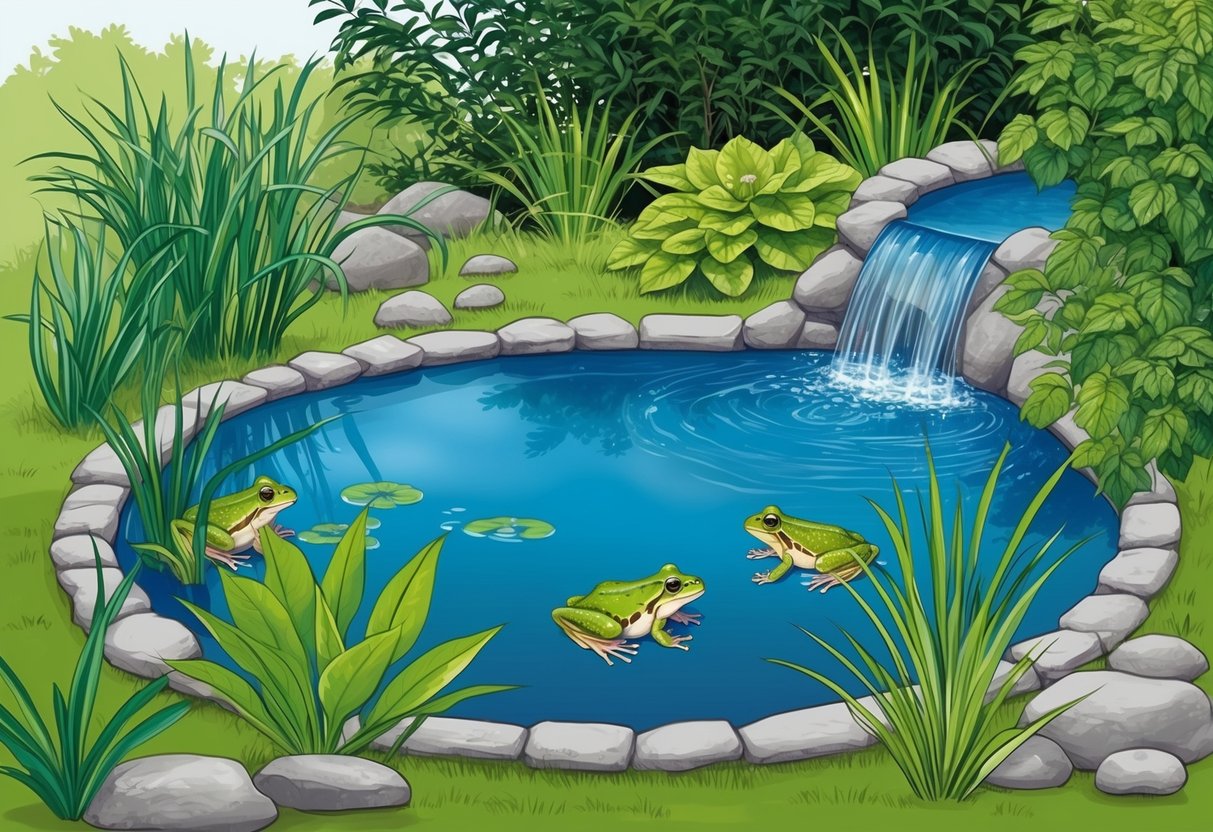
Keeping a close eye on your frog pond is key to its health. You’ll need to check the water and watch how the frogs behave. This helps you spot and fix problems early.
Testing Water Parameters
You should test your pond water often. Use a water testing kit to check pH, ammonia, and nitrate levels. The pH should be between 6.5 and 7.5 for most frogs. Ammonia and nitrates should be very low.
Test once a week at first. Later, you can test monthly if things are stable. Keep a log of your results. This helps you spot trends over time.
If you see sudden changes, act fast. You might need to do a partial water change. Or you may need to adjust your filtration system.
Observational Techniques
Watch your frogs daily. Healthy frogs are active and eat well. Look for frogs sitting in one spot for long periods. This could mean they’re sick.
Check for unusual behaviors or sounds. Frogs that are quiet when they’re usually noisy might be stressed.
Look at the pond itself too. Are there lots of algae? This could mean too many nutrients in the water. Is the water cloudy? You might need better filtration.
Count your frogs now and then. A sudden drop in numbers could signal a problem. Keep an eye out for predators around your pond too.
Maintaining Optimal Conditions
Keeping your frog pond in top shape requires regular care and attention. You’ll need to stay on top of routine tasks and manage plant growth to create a healthy habitat.
Regular Maintenance
Clean your pond filters every few weeks to keep the water clear. Remove dead leaves and debris that fall into the water. This prevents them from decaying and lowering water quality.
Check water levels often, especially in hot weather. Top up the pond with dechlorinated water when needed.
Test the water chemistry monthly. Use test kits to check pH, ammonia, and nitrate levels. Adjust as needed to keep conditions stable.
Trim back overgrown plants in spring and fall. This prevents them from taking over the pond.
Controlling Algae and Plant Growth
Some algae is normal, but too much can harm frogs. Use a pond skimmer to remove floating algae regularly.
Add floating plants like water lilies to shade the water. This naturally reduces algae growth.
Avoid chemical algaecides, as these can harm frogs. Instead, try barley straw as a natural algae control.
Don’t overfeed fish if you have them. Excess food leads to more algae.
Remove fallen leaves promptly in autumn. Decaying leaves feed algae growth.
Consider adding a small fountain or waterfall. Moving water discourages algae and adds oxygen.
Improving Water Quality
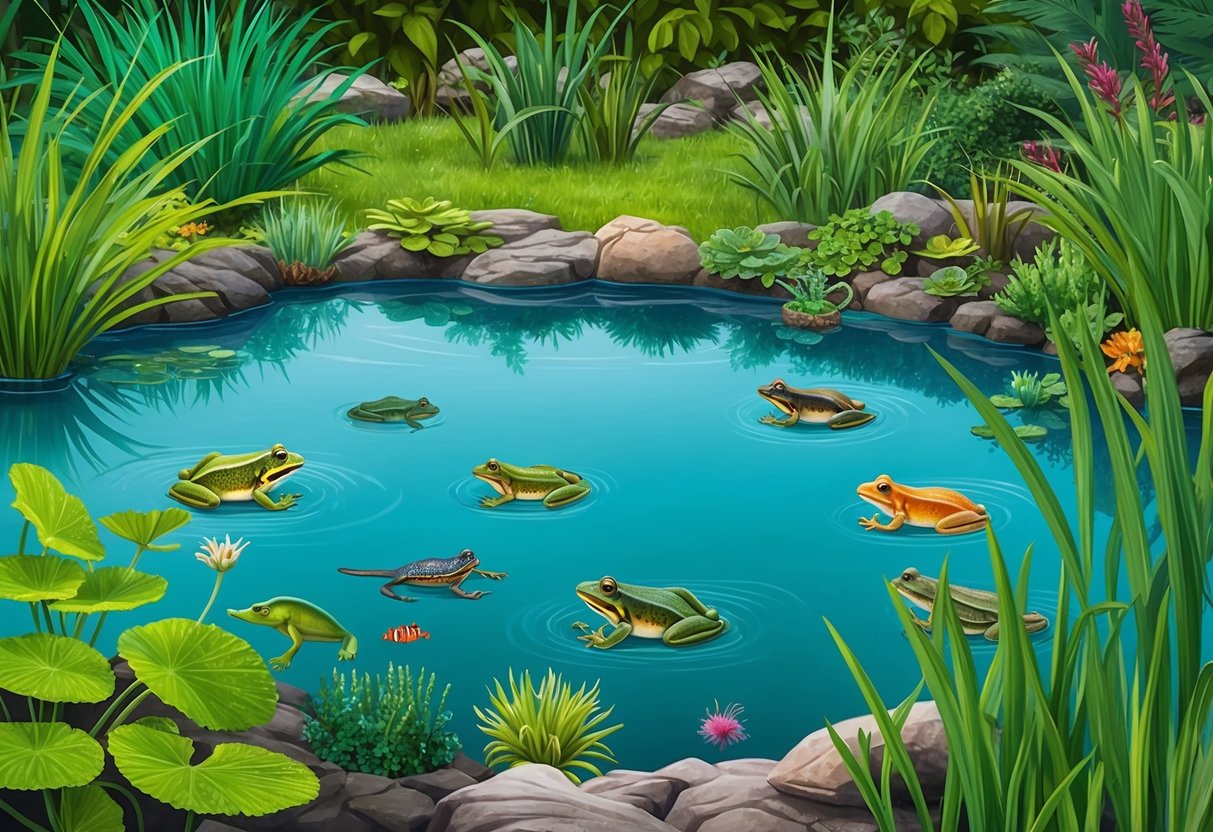
Good water quality is vital for frog health. You can use chemical treatments or natural methods to keep your pond clean and balanced.
Water Treatments
You can add chemicals to improve your frog pond’s water quality. Test kits help you check pH, ammonia, and nitrate levels. Aim for a pH between 6.5 and 7.5.
Use dechlorinator to remove harmful chlorine from tap water. Beneficial bacteria products break down waste and excess nutrients.
Algaecides control algae growth but use them carefully. They can harm frogs if used incorrectly.
Regular water changes are important. Replace 10-20% of the water weekly. This removes toxins and adds fresh water.
Natural Remediation Methods
Natural methods can improve water quality without chemicals. Add plants like water lilies to absorb excess nutrients. They also provide shade and habitat for frogs.
Introduce floating plants such as duckweed. They help control algae by blocking sunlight.
Create a biofilter using gravel and plants. It removes pollutants as water flows through.
Encourage helpful bacteria growth. They break down waste naturally. Add rocks or logs for bacteria to colonize.
Maintain a balanced fish population. Too many fish produce excess waste. Aim for one inch of fish per square foot of surface area.
Creating a Healthy Habitat for Frogs
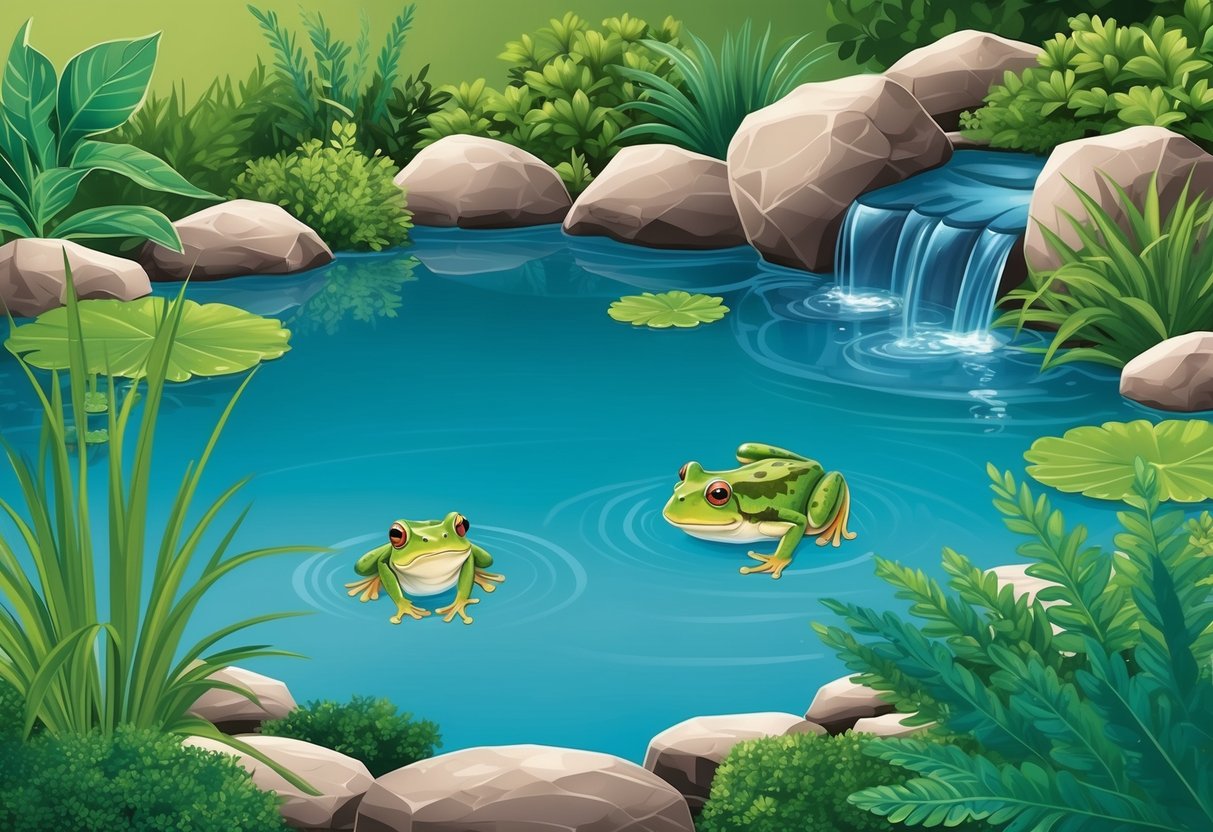
Frogs need a well-designed home with hiding spots and the right food. A good frog habitat keeps them safe and well-fed.
Shelter and Hiding Spots
Frogs love places to hide. You can create shelter using rocks, logs, and plants.
Put some large rocks around your pond’s edge. Frogs will use these to sun themselves.
Add some logs or branches near the water. Frogs can hide under these when they feel scared.
Plant native plants around your pond. Frogs will use the leaves and stems as cover.
Make sure to have both shallow and deep areas in your pond. Some frogs like to sit in shallow water, while others prefer to dive deep.
You can create different levels using rocks or small ledges.
Dietary Considerations
Frogs are hungry creatures. They eat lots of bugs. To keep your frogs well-fed, you need to attract insects to your pond.
Plant flowers and shrubs that bugs like. This will bring food right to your frogs.
Don’t use bug spray or weed killers. These can harm frogs and kill their food.
Some good plants to add are:
- Native grasses
- Wildflowers
- Berry bushes
These plants will draw in flies, moths, and beetles. All tasty treats for frogs!
You can also add a small light near your pond. This will attract night-flying insects for frogs to eat.
Just make sure the light isn’t too bright. Frogs need dark times too.
Frequently Asked Questions
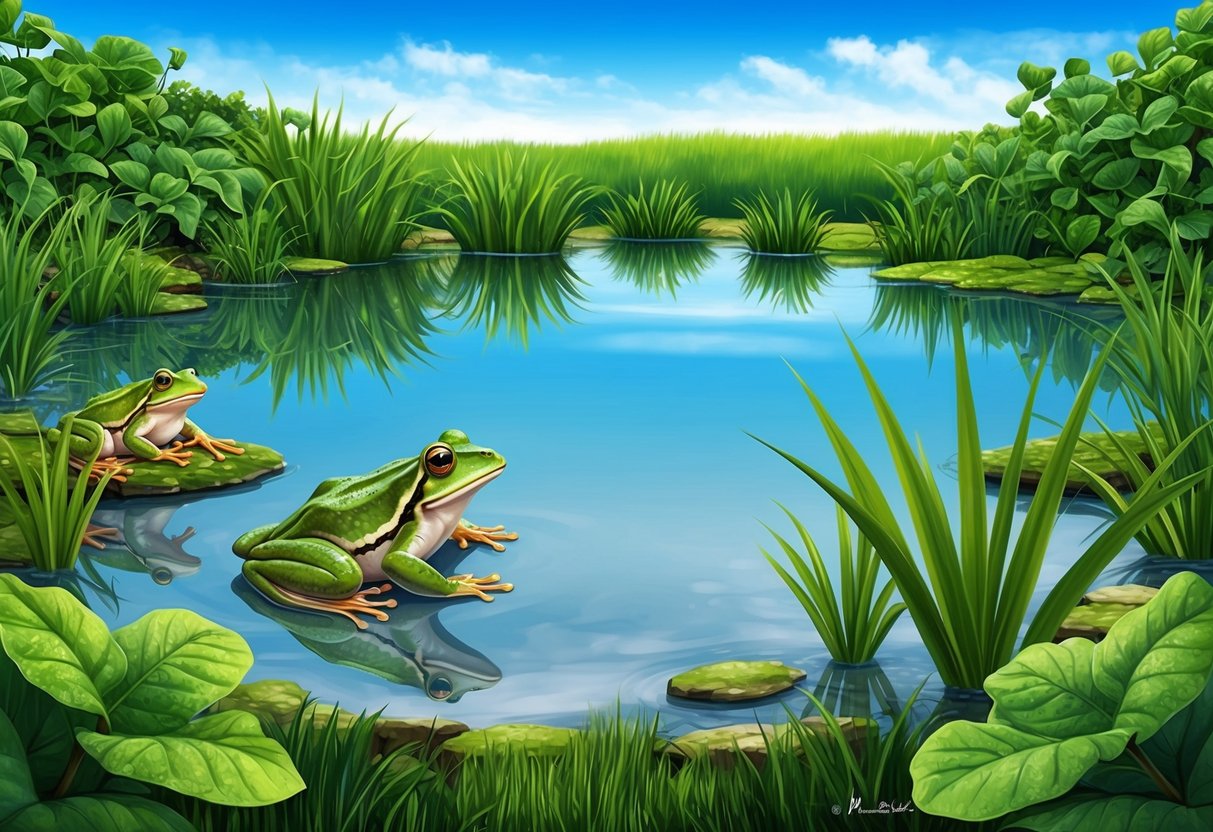
Frogs need clean water to thrive. Pollution, water quality, and environmental changes all affect frog survival in ponds. Let’s look at some key issues for frog habitats.
How does pollution affect the survival of frogs in ponds?
Pollution harms frogs in many ways. Chemicals in the water can damage frog skin and eggs.
Trash and debris make it hard for frogs to move and breathe.
Polluted water also kills insects frogs eat. With less food, frogs struggle to survive. Clean ponds are vital for healthy frog populations.
Can you explain why water quality is critical for amphibians?
Frogs absorb water and oxygen through their skin. Bad water quality hurts their bodies directly.
Dirty or toxic water can cause infections, deformities, and death in frogs.
Clean water lets frogs lay eggs safely. It also helps tadpoles grow strong. Good water quality means more frogs will survive to adulthood.
What role do frogs play in indicating the health of a pond ecosystem?
Frogs are nature’s warning system. They show when a pond is in trouble.
If frogs start dying or leaving, it means the water is likely unsafe.
Healthy frog populations point to a balanced ecosystem. Lots of frogs mean insects, plants, and other animals are doing well too. Watching frog numbers helps you track your pond’s health.
What are the consequences of land pollution on frog habitats?
Land pollution ruins frog homes. Trash and chemicals on land wash into ponds when it rains.
This makes the water toxic for frogs. Pollution also kills plants frogs need for shelter and food.
Without cover, frogs are easy targets for predators. Keeping the land around ponds clean protects frogs.
What water quality indices are crucial for maintaining successful frog culture?
pH levels are key for frogs. Most frogs like water with a pH between 6.5 and 7.5.
Too high or low can harm frog eggs and skin.
Oxygen levels matter too. Frogs breathe through their skin underwater. Low oxygen makes this hard.
Clean, moving water helps keep oxygen high.
Why are amphibians especially vulnerable to changes in their environment?
Frogs live on land and in water. This means they face twice the risks.
Changes in either place can hurt them. Their permeable skin is both a strength and weakness.
It lets them breathe easily but also absorbs pollutants quickly. Small changes in temperature or chemicals affect frogs fast.
